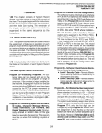
PROGRAMMING PROCEDURES-INSTRUCTIONWSYSTEMRECORDS
SECTION 200-096-302
FEBRUARY1991
line, a station user can press the Message
Waiting/Flash button and the CO line will
open (flash) for a period of either 2 sec-
onds, 0.2 seconds or 0.5 seconds depend-
ing on this assignment. A flash can also
be activated by dial code-II.
In general, this choice reflects whether to
disconnect and regain dial tone (2 sec-
onds),ortousePBXorCENTREXfeatures
which require a flash signal (0.5 seconds).
This flash timing also applies to flashes
inserted when dialing via Data Interface
Units (DIUs).
NOTE:
The 0.2 seconds option is not normally used
in the United States.
l
Pause After Flash, Code
%--Some Cen-
tral Offices or CENTREXfacilities require a
period of time after a flash signal before
they can accept dialing signals. A selection
of pause timing is available to automatically
delay any dialing signals after flash. This
timing applies to speed dial calls (with flash
signals between the telephone number
digits) as well as manual dialing.
l
CRCU Seize Time, Code
g-One channel
of the CRCU DTMF receiver/decoder is
seized when it is needed for the decoding
process, such as with a standard telephone
with DTMF dialpad. When placing outgo-
ing calls with DTMF standard telephones,
the talk path to the outside party is not “cut-
through” until the CRCU circuit is released.
The release time of the CRCU channel can
be programmed for a time between 1 and
9 seconds (initialized timing is 4 seconds);
this is the time it takes to release the CRCU
circuit after the last digit is dialed. The
choice of timing is a trade-off between CO
line time to connect and user speed. If the
time is too long, the outside called party
may answer before the voice path is “cut-
through,” and the caller will not be heard. If
the time is too short, a user inputting DTMF
tones could be cut off prematurely from
using other features, such as speed dial.
NOTE:
If no digits are dialed after accessicg an
outside line, the CRCU remains seized for ‘15
seconds and then drops; however, the CO
line remains connected.
Program 13-Defining the Message Center:
Each digital and electronic telephone can re-
ceive a maximum of four message waiting
indications. One of these four is reserved for
the designated Message Center. Typically, the
telephone (digital or electronic) accompanying
a DDSS or DSS console will be the Message
Center. However, if incoming traffic to a DDSS
or DSS console attendant is heavy, another
station may be assigned to be the Message
Center.
Program 15-Assigning DP/DTMF, Tenant
Service to Individual CO Lines:
l
Automatic Release (AR) on Voice Mail
Calls, Code 0 (Release
3)-If the Central
Office sends the AR signal after a CO line
call hangs up before the VM/auto atten-
dant transfers a call, “D” tone will be sent to
the voice mail port, releasing and clearing
that port for another call. If the outside
caller hangs up after the VM/auto atten-
dant hook flashes (to transfer the call), “D”
tone will not be sent to release the call.
l
CO Outgoing Signal, Code
l-Each CO
line can be independently assigned to have
either Dial Pulse or DTMF signaling.
l
CO Dial Pulse Rate, Code
2-If a CO line
is assigned Dial Pulse signaling, the rate
can be either 20 or IO pulses per second.
Some Central Offices do not reliably ac-
cept 20 pulses per second.
l
Automatic Release (AR), Code
3-Some‘
Central Offices will provide an AR signal
when the far-end calling party hangs up. If
the system CO line is on-hold when this
signal occurs, it will be automatically dis-
connected if this option is activated. Two-
CO line DISA calls always release when
AR is sent. DISA release via AR is not
related to this program
(Release
2 and
above).
2-6


















